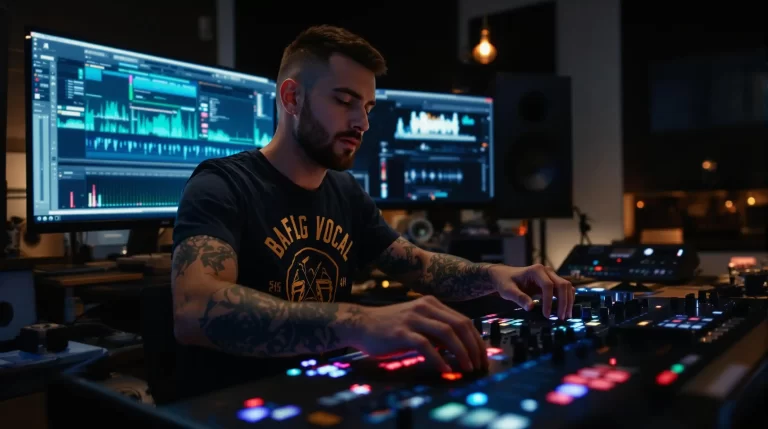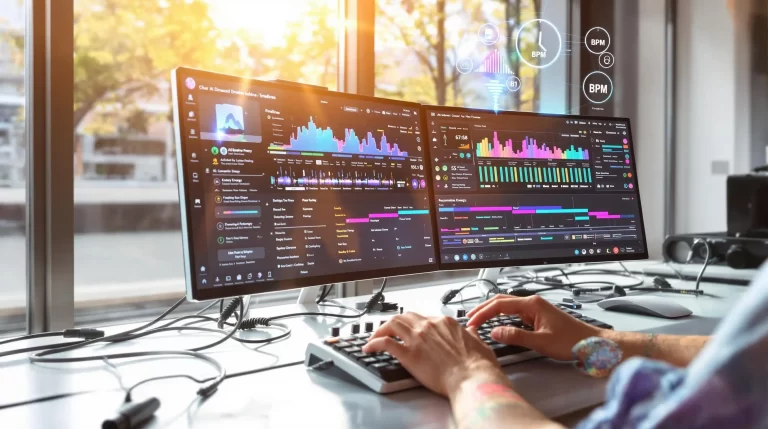AI Music Production Software: The Ultimate Guide for 2024
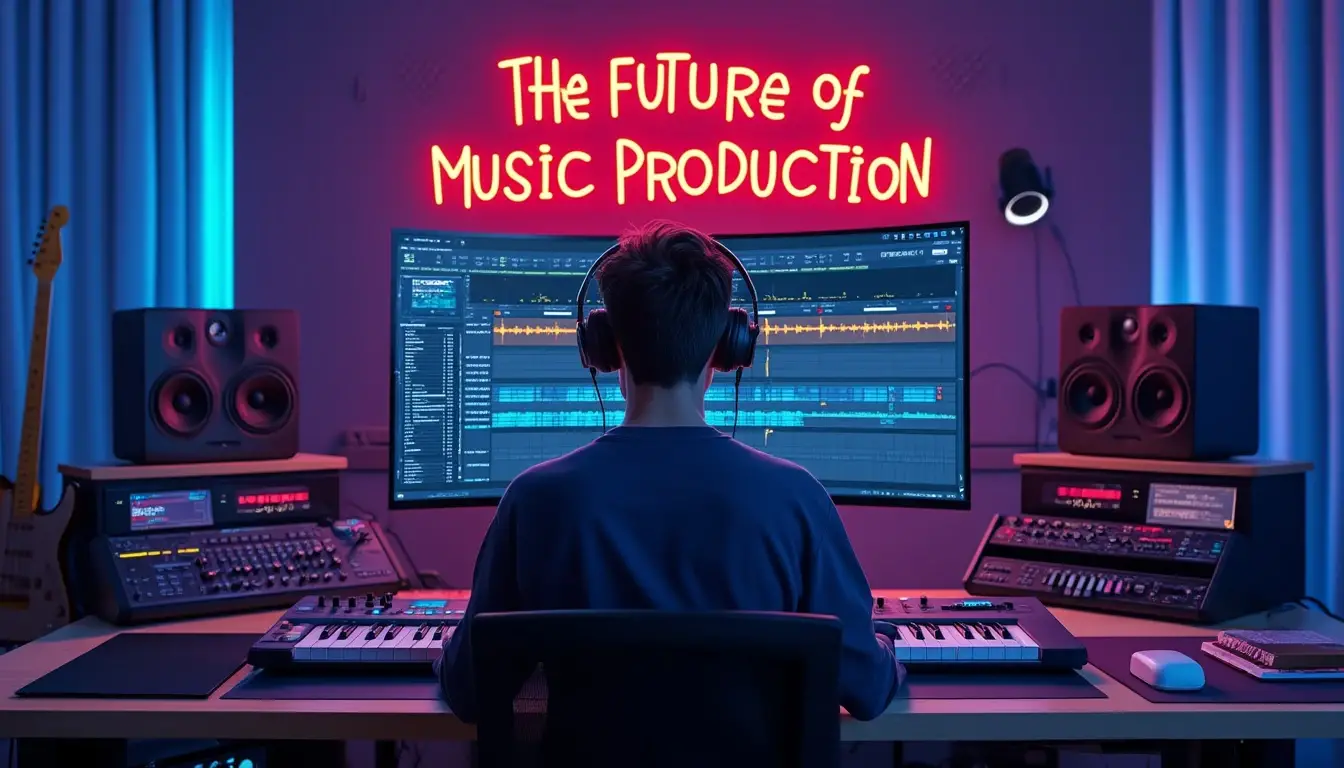
AI music production software has changed the way music is created in 2024. These music generation tools are more than just a trend; they are changing how artists make music. With the help of complex algorithms and large collections of music data, AI is allowing creators to explore new artistic possibilities.
This article explores the world of AI music production tools, looking at their features, benefits, and future potential.
You’ll learn about the main functions of these software solutions, including MIDI generation, audio manipulation, and style transfer. We’ll also discuss popular tools like LALAL.AI and Soundraw, giving you useful information to navigate this ever-changing field.
Scott Evans DJ is supported by its readers. If you purchase through any link on the site, we may earn a commission. Learn more
Understanding AI Music Production Software
Definition and Role in Music Composition
AI music production software uses artificial intelligence to help musicians be more creative. These tools look at musical data to create new songs, helping artists make one-of-a-kind sounds and tunes. This technology takes rough ideas and turns them into finished tracks, making the process of creating music more efficient and allowing for greater creativity.
How AI Algorithms Analyze Musical Data
AI algorithms are designed to sift through vast amounts of musical data. By identifying patterns, structures, and styles, they can produce AI-generated soundtracks that resonate with originality. These algorithms use methods like:
- Pattern Recognition: Finding recurring themes in existing music.
- Data Clustering: Grouping similar elements to understand genre-specific characteristics.
- Predictive Modeling: Anticipating future trends in music composition.
This analysis enables AI tools to create complex compositions that might take a human composer much longer to develop.
Key Functionalities of AI Music Production Tools
Several features set AI music production software apart from traditional Digital Audio Workstations (DAWs):
- MIDI GenerationAI tools can generate MIDI sequences based on user input or predefined parameters.
- Example: An artist inputs a chord progression, and the software generates complementary melodies and harmonies.
- Audio ManipulationAdvanced audio manipulation features allow users to tweak sounds with precision.
- Tools can automatically adjust tempo, pitch, and dynamics to match the desired style or mood.
- Style TransferStyle transfer involves applying characteristics from one piece of music to another.
- Example: Transforming a classical piano composition into an electronic dance track by infusing EDM elements.
These features make the music production process easier for musicians of all skill levels. The ability to quickly try out different musical ideas is invaluable for modern creators.
Case Study: Generating Unique Soundscapes
Consider a scenario where a film composer needs an original soundtrack for a sci-fi movie. Using AI music production software:
- The composer inputs thematic elements and moods they wish to evoke.
- The AI analyzes relevant musical data from various genres, including ambient, electronic, and orchestral music.
- The software generates multiple soundtrack options, each with unique soundscapes tailored to the film’s narrative.
This approach saves time and offers diverse musical options that align with the director’s vision.
Understanding these aspects of AI music production software reveals its transformative impact on music creation. The seamless integration of AI capabilities enhances the artistic process, enabling musicians to push creative boundaries while maintaining efficiency.
Key Features to Look for in an AI Music Production Tool
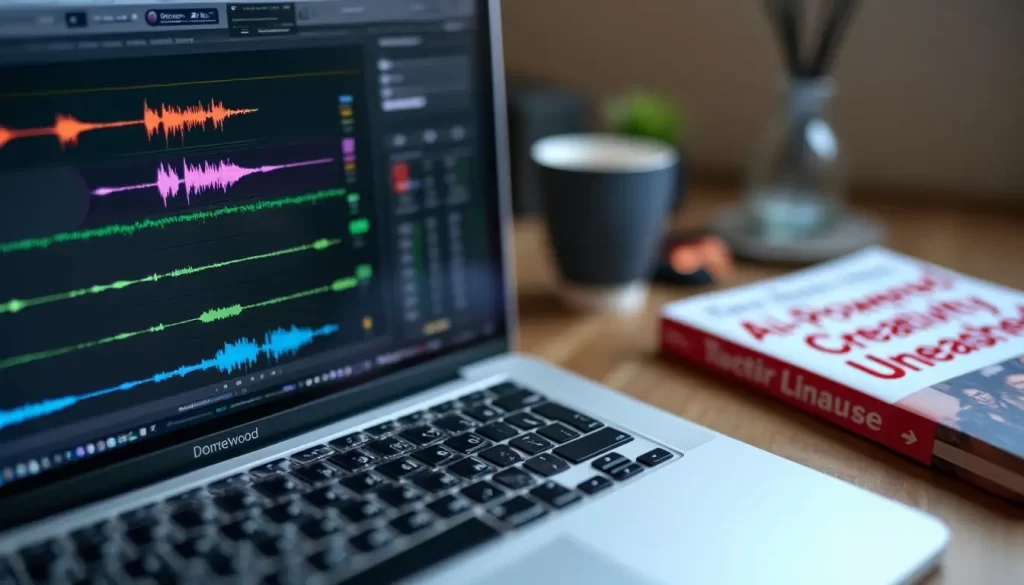
User-Friendly Interfaces
The success of any AI music production tool depends on how accessible it is. A user-friendly interface is crucial for musicians with varying technical skills to engage effectively with the software. Intuitive design ensures that users can navigate through features without needing extensive training or a steep learning curve. Icons, drag-and-drop functionalities, and customizable layouts make it easier for artists to focus on creativity rather than technicalities.
“The best AI tools are those that musicians can start using immediately, without getting bogged down by complex setups or confusing menus.”
Consider tools like Empress Chord Generator and Melody Muse, which offer simple yet powerful interfaces. These platforms allow users to generate chords and melodies effortlessly, streamlining the creative process.
Real-Time Collaboration Features
The modern music industry thrives on collaboration. Real-time collaboration features in AI music production software enable multiple artists to work on a project simultaneously, regardless of their geographical location. This functionality not only bridges physical distances but also enhances the creative workflow by allowing instant feedback and iteration.
Key benefits include:
- Instant Access: Collaborators can access the same project files in real time, making it easier to brainstorm ideas and make adjustments on the fly.
- Seamless Integration: Tools such as SoundfulAI and Boomy provide seamless integration with other digital audio workstations (DAWs) and cloud storage services.
- Enhanced Creativity: With real-time collaboration, musicians can combine their unique styles and perspectives to create richer, more diverse compositions.
“Collaboration is the heart of innovation. Real-time features empower artists to co-create without boundaries.”
In essence, when choosing an AI music production tool, prioritize platforms that offer an intuitive design and robust collaboration capabilities like those found in best collaborative design software. These features ensure that you can not only create high-quality music efficiently but also enjoy a dynamic and engaging creative process.
Exploring Popular AI Music Production Tools
LALAL.AI
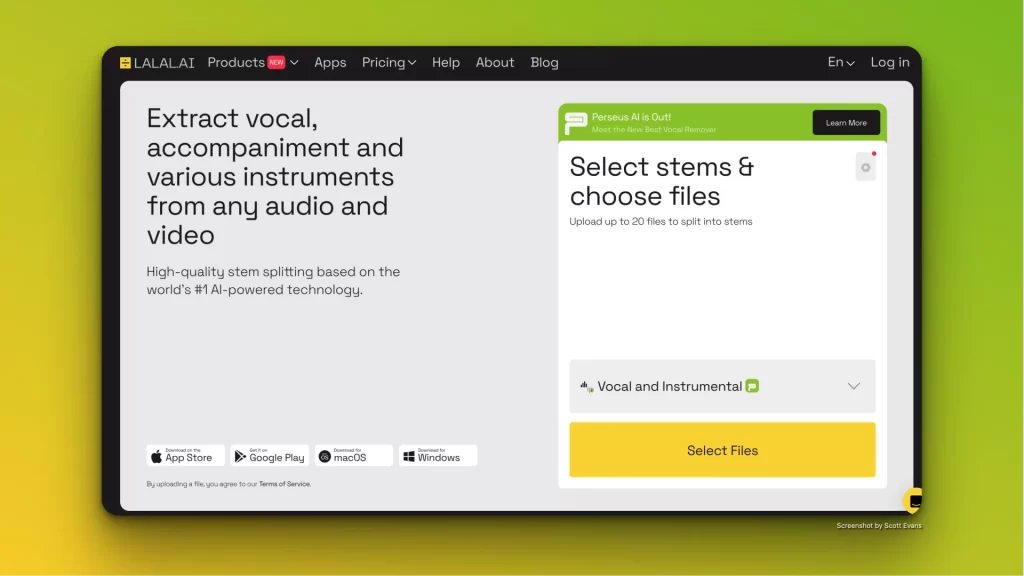
LALAL.AI stands out for its advanced stem separation capabilities. Targeting producers who need to isolate different elements of a track, this tool excels in extracting vocals, drums, and other instruments from any audio file. This feature is invaluable for remixing and sampling in genres like hip-hop and electronic dance music (EDM).
- Use Case: A DJ might use LALAL.AI to separate the vocals from a popular song to create a unique remix.
- Key Benefit: Precision in isolating stems without compromising audio quality.
Soundraw
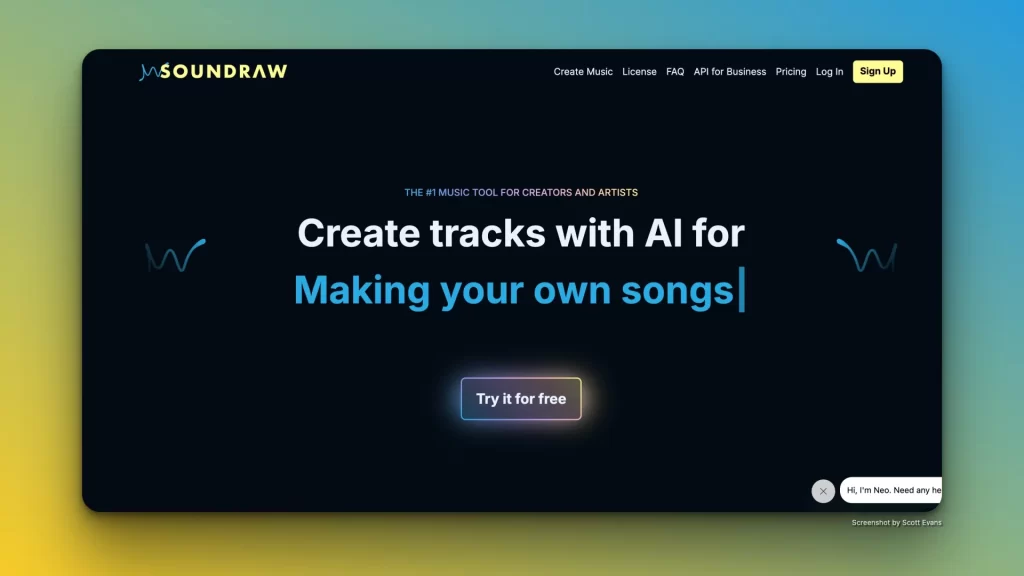
Soundraw focuses on generating royalty-free music tailored to the user’s needs. Designed for content creators and filmmakers, it allows users to customize the mood, tempo, and genre of their tracks. This adaptability makes it a go-to tool for producing background scores for videos, podcasts, or advertisements.
- Use Case: A YouTuber could leverage Soundraw to create an engaging intro theme that matches the energy of their channel.
- Key Benefit: High degree of customization with an intuitive interface.
ORB Producer Suite 3
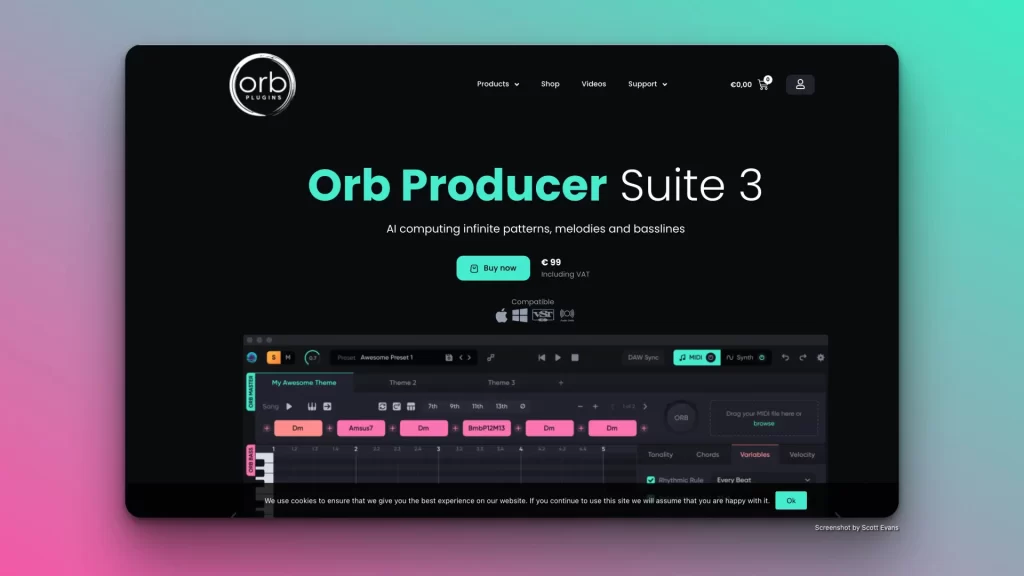
ORB Producer Suite 3 offers a suite of AI-driven tools that enhance the music composition process. Musicians can generate chords, melodies, basslines, and arpeggios effortlessly. Suitable for composers looking for inspiration across various musical styles, this tool integrates seamlessly with most Digital Audio Workstations (DAWs).
- Use Case: A composer working on an indie film score might use ORB Producer Suite 3 to draft complex chord progressions quickly.
- Key Benefit: Integration with DAWs enables smooth workflow transitions.
BandLab SongStarter
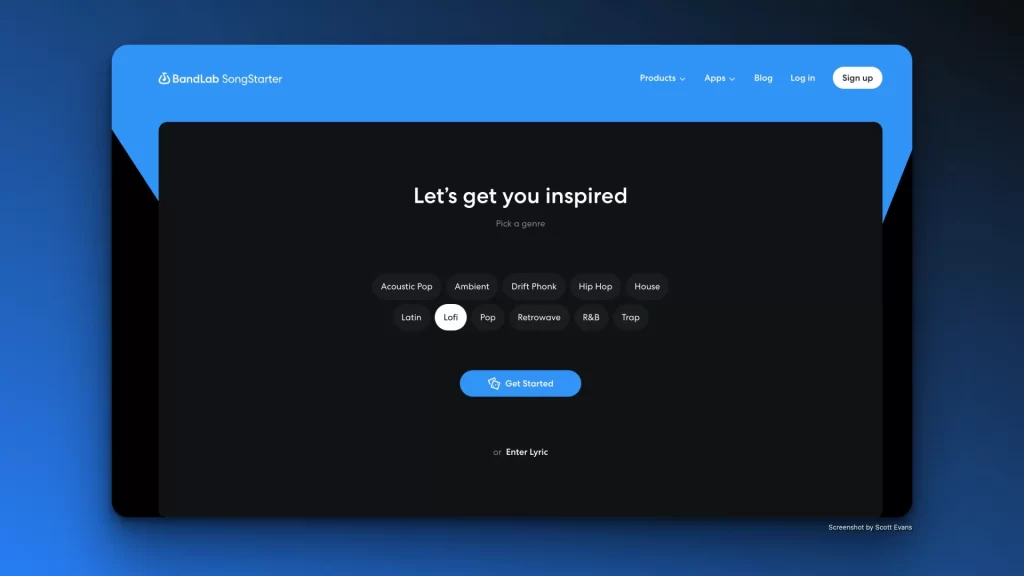
BandLab SongStarter is designed for musicians seeking instant inspiration. By providing randomized melody and chord progression ideas, it helps users overcome writer’s block. Ideal for beginners and seasoned artists alike, this tool fosters creativity across multiple genres including pop, rock, and jazz.
- Use Case: An aspiring songwriter could use BandLab SongStarter to kickstart their creative process when stuck on a new project.
- Key Benefit: Quick idea generation with accessible design.
Each AI music production tool offers unique advantages tailored to specific needs:
- LALAL.AI: Best for precise stem separation
- Soundraw: Perfect for customizable royalty-free music
- ORB Producer Suite 3: Comprehensive composition aid
- BandLab SongStarter: Instant inspiration generator
These tools collectively push the boundaries of what’s possible in music production today.
Advantages & Limitations of Using AI Music Production Software
Advantages
1. Cost-Effectiveness
AI music production software offers a significant reduction in production costs. Traditional music production often involves hiring session musicians and sound engineers and renting studio time, all of which can be expensive. AI tools streamline this by:
- Generating royalty-free music: Tools like SoundfulAI create background tracks that don’t require licensing fees, making them ideal for content creators on a budget.
- Customizable soundtracks: AI offers vast libraries of sounds and styles that can be tailored to specific needs without additional cost.
2. Efficiency
The integration of AI into your workflow accelerates the creative process:
- Rapid idea generation: Tools such as Melody Muse and Empress Chord Generator can instantly produce melodies and chord progressions, reducing the time spent on brainstorming.
- Automating repetitive tasks: From mixing to mastering, AI handles repetitive chores, allowing artists to focus more on creativity.
3. Accessibility
AI music production software is designed with user-friendly interfaces, making it accessible to musicians with varying technical skills:
- Intuitive design: Simplified controls and guided workflows make it easier for beginners to start producing high-quality music.
- Collaborative features: Real-time collaboration capabilities enable artists from different locations to work together seamlessly.
Limitations
1. Dependence on Pre-existing Datasets
One major drawback is the reliance on existing data:
- Algorithmic bias: AI-generated music often reflects the biases present in its training data, leading to potential homogenization in musical styles.
- Limited creativity: While AI can generate impressive compositions, it may lack the nuanced touch that human intuition brings. This constraint can result in music that feels less unique or emotionally impactful.
2. Potential Legal Challenges
AI-generated content brings about legal considerations:
- Copyright issues: The use of pre-existing datasets raises questions about originality and ownership of AI-created works.
- Navigating legal frameworks: Musicians need to be aware of the evolving legal landscape surrounding AI-generated content to avoid potential infringements.
3. Ethical Concerns
The rise of AI in music production sparks ethical debates:
- Loss of human touch: As AI takes over more aspects of music creation, there’s a concern about losing the human element that makes music deeply personal and expressive.
- Job displacement: The efficiency and capabilities of AI might lead to fewer opportunities for traditional roles within the industry.
Understanding these advantages and limitations helps musicians make informed decisions about incorporating AI into their creative processes. Balancing innovation with artistic integrity ensures that technology enhances rather than diminishes the art of music-making.
The Future of AI in Music Production
The world of AI in music production is changing quickly, thanks to new technology and creative uses. According to predictions, the AI music industry is expected to grow significantly by 2033, with a projected market value of USD 38.7 billion and a compound annual growth rate (CAGR) of 25.8% from 2024 to 2033.
Emerging Trends
1. VR Integration
Virtual reality (VR) is changing how artists use music creation tools. With VR, producers can enter a virtual studio and have an immersive experience, allowing for greater creativity and involvement. Picture this: instead of just using a computer screen, you can now compose and arrange music in a fully interactive 3D environment, where you can move around and control virtual instruments and effects with natural hand movements. This not only makes the process of creating music more exciting but also opens up new possibilities for live performances and connecting with audiences.
2. Sustainable Practices
Sustainability is becoming increasingly important in the music industry, and AI tools are playing a crucial role in making this shift happen. With the help of AI, we can find ways to use resources more efficiently and reduce the environmental impact of traditional music production methods. Here are a couple of examples:
- Energy-efficient Algorithms: Instead of using complex algorithms that require a lot of computing power, we can develop smarter algorithms that achieve the same results with less energy consumption.
- Recycling Audio Elements: Instead of constantly creating new sound samples and loops, we can encourage musicians to reuse existing audio elements in their productions.
By embracing sustainable practices like these, AI music production software can contribute to a greener approach while still delivering top-notch quality.
Community-Driven Platforms
Community-driven platforms are bringing musicians together and encouraging collaboration. These platforms leverage the power of collective intelligence to enhance AI capabilities in music production. Here’s what users can do on these platforms:
- Share custom AI models and presets
- Collaborate on projects in real time
- Provide feedback that helps improve AI algorithms
This collaborative ecosystem not only makes advanced music production tools accessible to more people but also speeds up innovation through shared knowledge and experiences.
AI’s integration into music production is set to grow significantly, driven by trends such as VR integration and sustainable practices. These developments promise a future where creating music becomes even more immersive, efficient, environmentally friendly, and aligned with emerging music streaming trends.
Challenges & Considerations When Embracing AI Music Technology
When exploring the world of AI music production software, there are several challenges and factors to consider. These issues range from creative worries to legal complexities.
Homogenization in Musical Styles
One major concern is the potential for musical styles to become more uniform:
- Algorithmic Bias: AI algorithms are trained on existing datasets, which may unintentionally favor certain styles or patterns. This can result in a lack of diversity in the music created.
- Absence of Human Touch: The human element in creativity cannot be replaced. Music made by AI might lack the emotional depth and uniqueness that comes from human experiences and expressions.
Legal Challenges with Copyright Ownership
The rise of content created by AI brings up several legal questions:
- Copyright Ownership Issues: Figuring out who owns the copyright for music made by AI is complicated. Traditional copyright laws do not clearly state whether the creator of the algorithm, the user, or the AI itself has rights to the content produced.
- Navigating Legalities: Musicians need to be aware of potential legal pitfalls and make sure they navigate these challenges effectively to protect their work.
Dependency on Pre-existing Data
AI tools heavily rely on existing musical data:
- Data Quality and Diversity: The quality and diversity of the dataset used to train AI models have a significant impact on the output. A limited or biased dataset can restrict creativity and innovation.
- Ethical Considerations: Using copyrighted material without proper permissions to train AI models raises ethical questions. It is crucial to ensure ethical sourcing of data for sustainable development in this field.
Technical Limitations
Despite advancements, there are still technical constraints:
- Real-Time Processing: While many tools offer features for real-time collaboration, capabilities for real-time processing are still evolving. Latency issues can disrupt smooth creativity during collaborative sessions.
- Complexity in Integration: Integrating AI tools with existing Digital Audio Workstations (DAWs) can be challenging. Compatibility issues may arise, requiring additional technical expertise.
Understanding these challenges helps musicians make informed decisions when incorporating AI music production software into their workflow. Balancing innovation with awareness ensures a harmonious blend of technology and artistry.
Conclusion
Choosing the best AI music generators depends on your specific needs and artistic goals. If you prioritize speed, tools like Boomy and SoundfulAI offer quick and efficient song generation, making them ideal for users who want to produce content rapidly.
However, if you value artistic control and customization, software such as AIVA or Orb Producer Suite might be a better fit. These platforms allow musicians to have more control over compositional elements, enabling them to add their unique touch to each piece.
Key Considerations:
- User-Friendly Interfaces: Ensure the tool is accessible regardless of your technical skill level.
- Collaboration Features: Look for real-time collaboration capabilities if working with other artists is crucial.
- Specific Functionalities: Identify what functionalities are most important—whether it’s melody generation, chord progression, or lyric creation.
The world of AI music production offers many options for different creative processes. By understanding what each tool has to offer, you can make an informed decision that aligns with your musical aspirations.
Ready to explore the world of AI music production software? Start by checking out the best AI music production tools mentioned in this guide. Whether you want speed, artistic control, or a combination of both, there’s an AI tool designed just for you.
Here’s how to get started:
- Try Out Different Tools: Explore Empress Chord Generator, Melody Muse, Lyricist AI, and others to find the one that suits your creative process.
- Use Resources: Make use of guides and tutorials to effectively master these tools.
- Connect with Others: Interact with fellow musicians who are using AI tools. Online platforms such as forums and social media groups can provide valuable insights and support.
- Stay Informed: Keep up with the latest trends in AI music production to ensure your workflow remains innovative and efficient.
Start your creative journey now by exploring the top AI music production software out there. Your next hit could be just an algorithm away!
FAQs (Frequently Asked Questions)

DJ Scott Evans
Hey there! I’m Scott Evans, DJ and music tech enthusiast who’s gone all-in on AI music tools. After years behind the decks and geeking out over gear, I discovered how AI can unlock incredible creative possibilities for musicians like us. On this site, I break down complex AI music tech into easy-to-follow tutorials and honest reviews. Think of me as your friendly guide through the AI music revolution – no technical jargon, just practical tips to elevate your sound. Let’s explore what these digital tools can do for your creativity!

